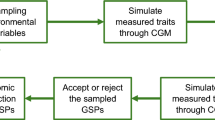Summary
Within-plot coefficients of variability of F1 maize hybrids and of their inbred parents were determined for several plant and ear characteristics over a two-year period.
The heterozygous hybrids as a group were found to be better buffered (lower coefficients of variation) than the homozygous parents in every characteristic. There appeared to be significant differences in buffering among the hybrids only for ear node height; the inbred parents, however, differed significantly among themselves in buffering for plant height, ear node height, maturity, ear weight, and ear length.
These results suggest that any proposal designed to explain homeostasis in maize must satisfy these two kinds of evidence: heterozygote superiority and differences among homozygotes.
A proposal is outlined invoking systems of alternative biosynthetic pathways which function under different environmental optima. These systems are controlled in maize heterozygotes by alternative alleles of a single gene or by non-alleles of two or more loci. In maize homozygotes they are controlled by non-alleles. The essential role of genic function at diverse environmental optima is emphasized.
Similar content being viewed by others
References
Byrd, W. F. (1955). Genetic and environmental variances in segregating and non-segregating maize populations. Unpublished Ph.D. thesis, Iowa State College Library, Ames, Iowa.
Comstock, R. E. (1955). Theory of quantitative genetics: synthesis. Cold Spring Harbor Symposia on Quantitative Biology,20, 93–102.
Dobzhansky, T. &Levene, Howard (1955). Genetics of natural populations. XXIV. Developmental homeostasis in natural populations ofDrosophila pseudoobscura. Genetics,40, 797–808.
Dobzhansky, T. &Wallace, B. (1953). The genetics of homeostasis inDrosophila.Proc. Nat. Acad. Sci., Wash.,39, 162–171.
Everett, H. L. (1950). A proposed relationship between suppressor gene mutants and heterosis. Genetics (abs.),35, 663.
Fox, Sidney W. (1953). A correlation of observations suggesting a familial mode of molecular evolution as a concomitant of biological evolution. The American Naturalist,87, 253–256.
Haldane, J. B. S., (1954). The Biochemistry of Genetics. New York: The MacMillan Co.
Harvey, Paul H. (1939). Hereditary variation in plant nutrition. Genetics,24, 437–461.
Haskell, G. (1952). Heterosis and Adaptability, Rep. 13. Int. Hort-Cong. 365–374.
Jinks, J. L. (1954). The analysis of continuous variation in a diallel cross ofNicotiana rustica varieties. Genetics,39, 767–788.
Lerner, I. Michael (1954). Genetic Homeostasis. New York: John Wiley & Sons, Inc.
Lewis, D. (1953). A relationship between dominance, phenotypic stability and variability and a theory of alternative genetic pathways. Nature (London),172, 1136–37.
Lewis, D. (1954). A relationship between dominance, heterosis, phenotypic stability and variability. Heredity,8, 333–356.
Mather, Kenneth (1953). Genetical control of stability in development. Heredity,7, 297–336.
McLaren, Anne &Michie, Donald (1956). Variability of response in experimental animals: a comparison of the reactions of inbred, F1 hybrid and random bred mice to a narcotic drug.J. Genet. 54, 440–455.
Robertson, F. W. &Reeve, E. C. R. (1952). Heterozygosity, environmental variation and heterosis. Nature,170, 286.
Thoday, J. M. (1955). Balance, heterozygosity and developmental stability. Cold Spring Harbor Symposia on Quantitative Biology,20, 318–326.
Went, F. W. (1953). Gene action in relation to growth and development. I. Phenotypic variability.Proc. Nat. Acad. Sci., Wash.,39, 839–848.
Yoon, Chai H. (1955). Homeostasis associated with heterozygosity in the genetics of time of vaginal opening in the house mouse. Genetics,40, 297–309.
Author information
Authors and Affiliations
Additional information
Approved for publication by the director of the South Dakota Agricultural Experimental Station as Journal Series No. 417.
Rights and permissions
About this article
Cite this article
Shank, D.B., Adams, M.W. Environmental variability within inbred lines and single crosses of maize. J Genet 57, 119–126 (1960). https://doi.org/10.1007/BF02985341
Received:
Issue Date:
DOI: https://doi.org/10.1007/BF02985341




